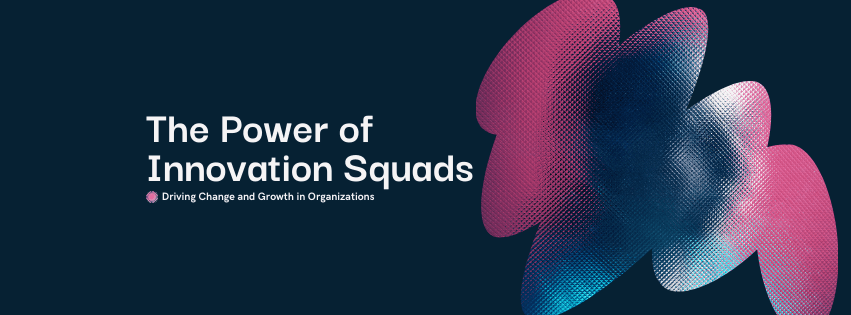The Power of Innovation Squads: Driving Change and Growth in Organizations
In today’s fast-paced business environment, innovation is not just a buzzword; it is essential for success. Organizations must continuously adapt to changing market dynamics, consumer preferences, and technological advancements to remain competitive.
One effective approach companies are increasingly adopting to foster innovation is the establishment of Innovation Squads. In this blog post, we’ll explore the concept of innovation squads in detail, including their roles, processes, tools, and the immense value they add to organizations.
What is an Innovation Squad?
An Innovation Squad is a small, cross-functional team within an organization dedicated to exploring new ideas, developing innovative products or services, and driving organizational change.
These squads operate with a high degree of autonomy, empowered to experiment, take risks, and challenge the status quo. Their primary objective is to create value through innovation by leveraging diverse perspectives and expertise from various departments within the organization.
Characteristics of Innovation Squads
Cross-Functional Composition
Innovation squads consist of members from diverse departments such as product development, marketing, design, finance, and customer service.
This diversity fosters creativity and encourages innovative thinking by bringing different perspectives to the table.
Agility and Flexibility
Operating in an agile manner allows squads to pivot quickly based on feedback or changing market conditions. This adaptability is crucial in today’s dynamic business environment.
Focus on Experimentation
A culture of experimentation enables team members to test new ideas without the fear of failure. This iterative process leads to valuable insights that can drive future innovations.
Alignment with Business Goals
While innovation squads have the freedom to explore new ideas, their efforts are always aligned with the organization’s strategic objectives to ensure that innovations contribute to overall business growth.
Key Roles within an Innovation Squad
Innovation Lead
The Innovation Lead oversees the squad’s vision and ensures alignment with broader organizational goals. Their responsibilities include:
- Establishing clear objectives.
- Communicating progress to stakeholders.
- Facilitating collaboration among team members.
- Removing obstacles to innovation efforts.
Product Manager
The Product Manager identifies market opportunities and guides product or service development by:
- Conducting market research.
- Gathering customer feedback.
- Defining product requirements.
- Evaluating post-launch performance.
Researcher
The Researcher focuses on gathering insights that inform decisions by:
- Analyzing industry trends and emerging technologies.
- Synthesizing data into actionable insights.
- Monitoring ongoing market developments.
Designer
The Designer creates user-centric designs by:
- Conducting user research.
- Developing prototypes and wireframes.
- Testing designs with real users.
Developer
The Developer turns ideas into functional prototypes or products by:
- Writing code for new features.
- Conducting unit tests and debugging.
- Ensuring scalability and performance.
Business Analyst
The Business Analyst evaluates the financial viability of ideas by:
- Conducting cost-benefit analyses.
- Developing financial forecasts.
- Assessing market potential.
The Innovation Process: From Idea Generation to Implementation
Idea Generation
Brainstorming sessions, design thinking workshops, and hackathons help squads generate a wide range of ideas based on research and trends.
Idea Screening
Ideas are evaluated against criteria like feasibility, business alignment, potential impact, and resource requirements to prioritize the most promising ones.
Prototyping
Prototypes—ranging from low-fidelity sketches to digital mockups—are created to visualize concepts and gather stakeholder feedback.
Testing
User testing sessions help refine prototypes based on real feedback, ensuring usability and desirability.
Implementation
Validated ideas are developed into final products, with designers and developers collaborating closely to prioritize user experience.
Launch and Evaluation
The final product or service is launched, followed by performance monitoring and feedback collection for future iterations.
Tools That Empower Innovation Squads
Collaboration Tools
Platforms like Slack, Microsoft Teams, and Trello enable seamless communication and task management.
Design Tools
Tools such as Figma, Sketch, and Adobe XD allow designers to create and share prototypes in real-time.
Prototyping Tools
Solutions like InVision, Axure, and Marvel App help squads create interactive prototypes.
Research Tools
Insights are gathered using tools like SurveyMonkey, Google Analytics, and Typeform.
Project Management Tools
Software like Asana, Jira, and Monday.com helps squads manage timelines and accountability.
Building an Effective Innovation Squad: Best Practices
Define Clear Objectives
Set goals aligned with organizational strategy to ensure meaningful outcomes.
Foster a Culture of Trust
Encourage open communication where team members feel safe sharing ideas.
Invest in Training
Provide training in design thinking and agile practices to enhance squad effectiveness.
Encourage Cross-Pollination
Facilitate knowledge sharing across teams through workshops and joint sessions.
Measure Success
Use key performance indicators (KPIs) to track progress and assess outcomes.
Enhancing Customer Experience Through Innovation
Drive-Thru Innovations
Companies like Starbucks have enhanced drive-thru experiences by optimizing layouts and incorporating digital menu boards for efficiency. Learn more about Starbucks’ innovations on their official website.
Expanding Delivery Services
Partnerships with platforms like Uber Eats enable seamless delivery experiences, meeting customer demands for convenience.
Business Value Added by Innovation Squads
Enhanced Competitiveness
Continuous exploration of ideas ensures agility and market adaptability, leading to increased market share.
Improved Efficiency
Streamlined processes reduce time-to-market, driving revenue growth.
Increased Customer Satisfaction
User-centric solutions foster loyalty and trust.
New Revenue Streams
Innovative products open up new income sources, diversifying revenue.
Attracting Top Talent
Organizations known for fostering creativity attract high-caliber professionals.
Conclusion
Innovation squads represent a transformative approach to problem-solving and growth in modern organizations. By embracing cross-functional collaboration and fostering a culture of trust and experimentation, companies position themselves to thrive amidst uncertainty. As we venture into the future, nurturing environments that prioritize creativity and innovation will be pivotal to unlocking new opportunities and achieving sustained success.
For more insights on building innovation-driven teams, check out resources from Harvard Business Review and McKinsey & Company.


